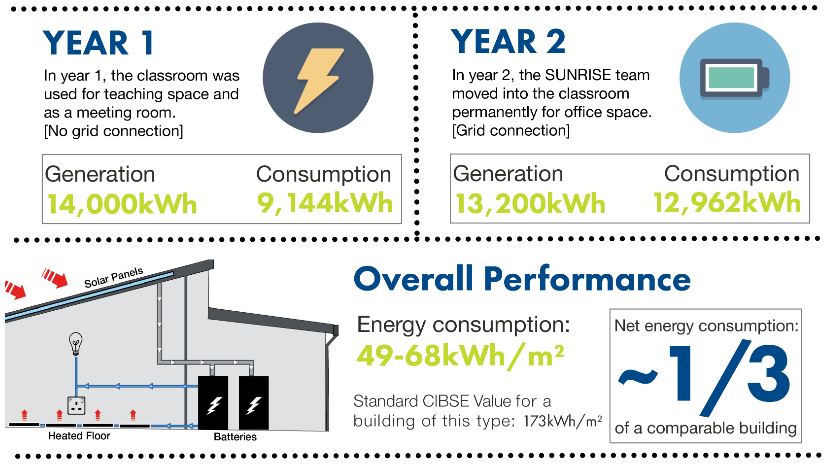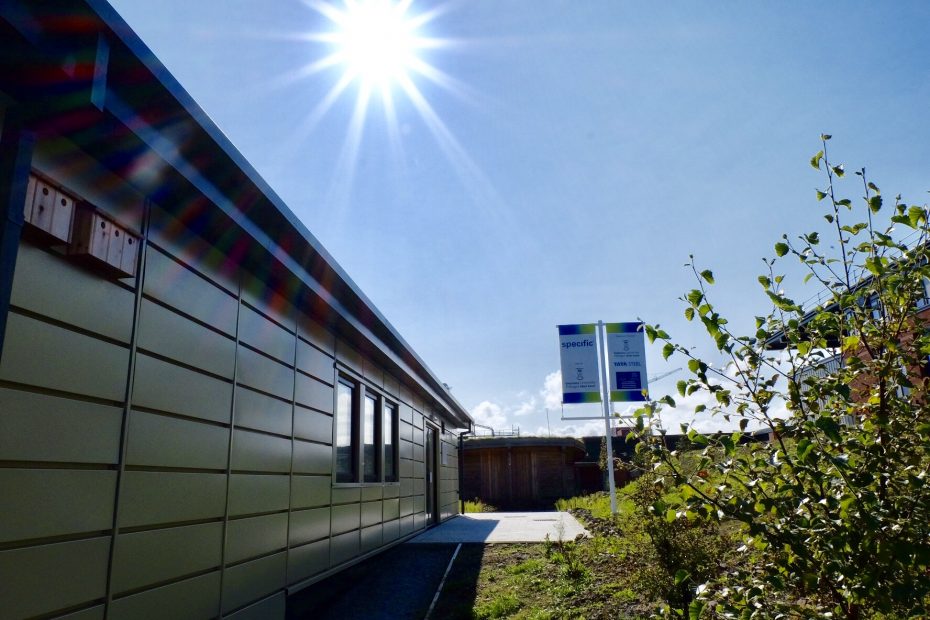This series of articles is a partnership between SPECIFIC, SUNRISE and the Active Building Centre. Our projects work with academic, industry and community partners in the UK and the Global South to research and develop solar technologies and to drive change in the construction industry.
While our projects each have distinct objectives and approaches, our shared message is simple: buildings don’t have to cost the Earth.
Our vision for transformation comes with many challenges across technical, political, social and economic norms. In this series we will share some of the work we’re doing to address each of these. This is the third blog of nine, and is an update on The Active Classroom – which has recently celebrated its 2nd year of operation.
Our first full-size Active Building demonstrator, the Active Classroom, was an experiment using a combination of ‘off-the-shelf’ technology and emerging technology. The aim was to test the Active Buildings design principle in a real, full-scale, occupied building…and after running for two years, it’s still providing insights AND performing well.
Generating more energy than it needs:
The good news is that after its second full year of operation it has again generated more energy than consumed. This is despite a significant change in use, with the smaller teaching space now housing an office for 5 people and related IT and support services. We have seen the energy demand increase by approx. 30% showing the additional power requirements related to an office environment and, of course, the requirement for copious teas and coffees!
“Because of the way the technologies are integrated into the building design, it is in fact quite easy to forget that all the energy we use, to run our computers, power the lights, boil the kettle and so on, is generated from the sun – we just go about our day-to-day activities like any other office! It’s the perfect HQ for the SUNRISE team as we aim to tackle climate change through installing similar buildings in India.” [Georgia Bevan, SUNRISE project]
The technologies are performing well together, and annual energy consumption is about a third of a typical building of this type, when compared to the standard CIBSE values for a Further Education Teaching Space.
What next?
As it’s an experimental space we are constantly refining and developing the systems, using what we’ve learned so far. For example, we noticed recently that the Maximum Power Point Tracking charge controller (MPPT), which regulates the voltage and current from the photovoltaic roof, was potentially limiting the performance of the roof on the sunniest days. We are therefore changing and upgrading the electrical layout of these devices to maximise electricity generation from the roof.
Later this year we will also change the 60kWh saltwater electrolyte batteries to 120kWh flow cell batteries from RedFlow, which will double the electricity storage capacity in the building. The flow cell technology is particularly interesting as there is very little experience of this type of technology in Europe, and it has some relevant properties for building applications such as the potential to scale well to larger storage capacities.
The heated floor, a product developed and manufactured by SPECIFIC, has performed very well and is the primary source of heating in the main teaching space. The control system and the power supplies have been further developed over the last 2 years and we have shown that the control and response is suitable for this kind of application. The low thermal mass, combined with a suitable control system helps to reduce thermal overshoot that can occur in traditional underfloor heating systems. The system can maintain a comfortable temperature when large numbers of people enter the room, as well as when the classroom has fewer occupants.

Energy communities:
With the arrival of the Active Office and a permanent grid connection the two buildings can demonstrate how buildings with different occupancy and energy consumption profiles can complement each other and the local network. In order to display the aggregated energy data across both buildings, we’re working on an electronic display screen and digital system like that of the Office – this is the first step in building a more comprehensive view of the demonstration buildings energy performance as a distributed system.
With the recent ban on gas boilers in new builds by 2025, finding alternative heating solutions will be key to decarbonisation in buildings. The research and development of our inter-seasonal energy store has been progressing and we are hoping that, in the next few months, we will be able to trial our first demonstration unit in the classroom. Once installed, the system will be capable of releasing stored thermo-chemical energy as supplementary heating for the classroom kitchen area.
Watch the video below for more information on how SUNRISE, SPECIFIC, and the Active Building Centre work together to show how buildings can be designed differently:
Read other blogs in this series with SUNRISE and ABC:
Blog #1: Public involvement with a community in India: Q&A with Carol Maddock and Khushboo Ahire
Blog # 2: Designing Active Buildings
